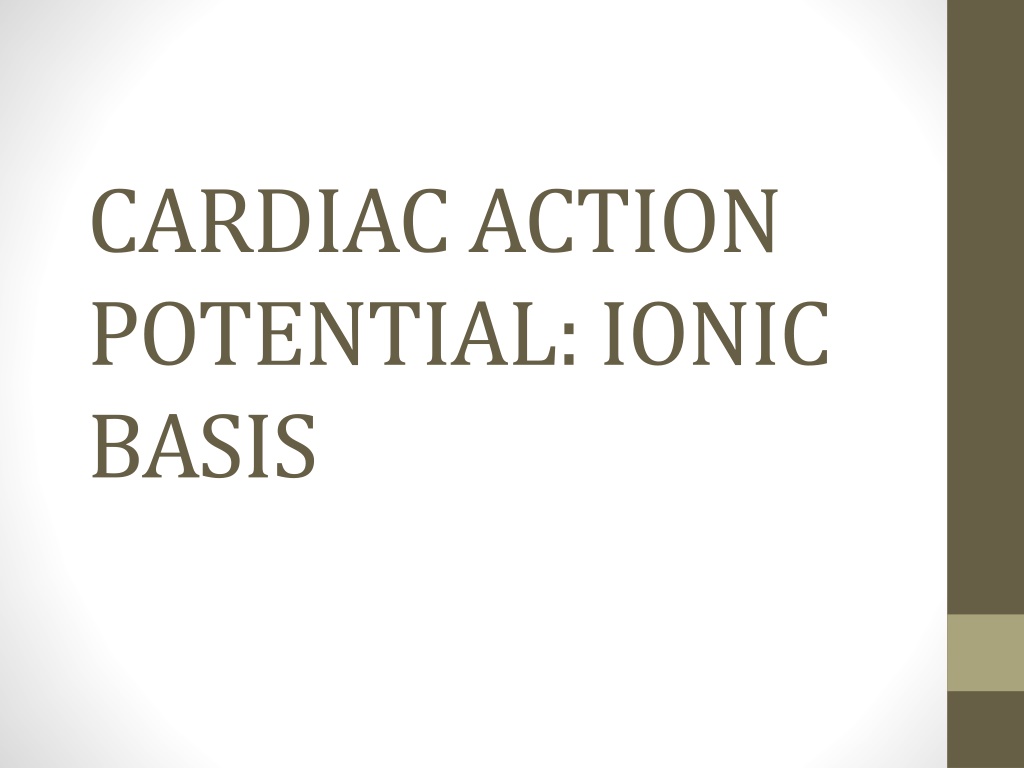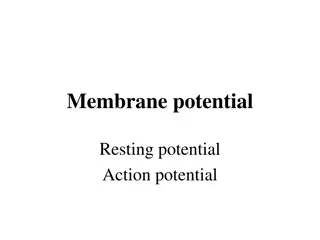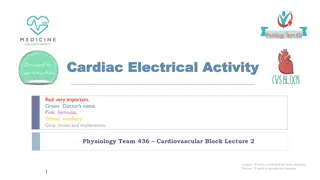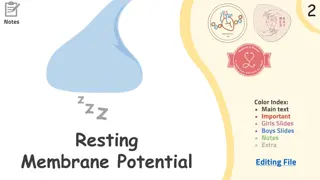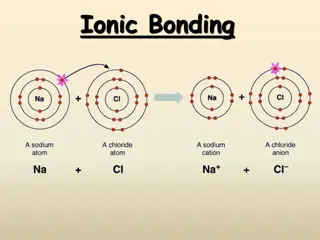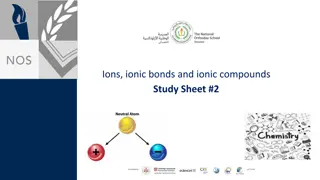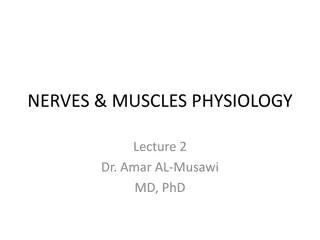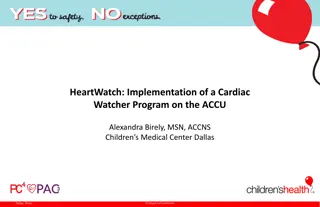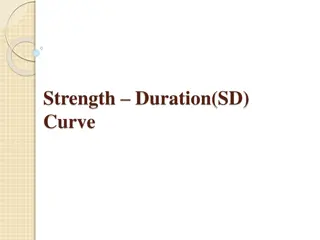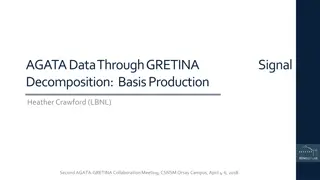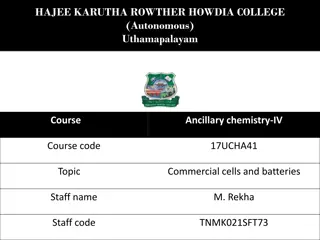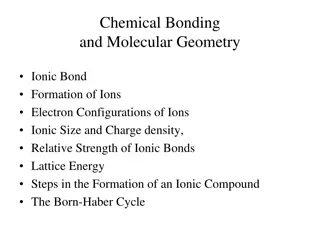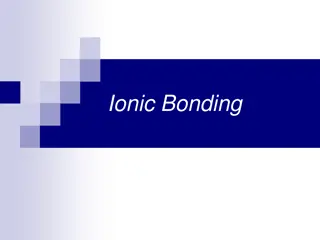Understanding Cardiac Action Potential: Ionic Basis and Excitability in Cells
Explore the complex processes underlying cardiac action potential, from ionic equilibrium to resting membrane potential and excitability in cardiac cells. Learn about the critical thresholds, equilibrium potentials, and gradients that regulate the electrical activity of the heart. Discover the intricate interplay of ion movements and channels that drive the generation and propagation of action potentials in the cardiac system.
Uploaded on Sep 18, 2024 | 0 Views
Download Presentation

Please find below an Image/Link to download the presentation.
The content on the website is provided AS IS for your information and personal use only. It may not be sold, licensed, or shared on other websites without obtaining consent from the author. Download presentation by click this link. If you encounter any issues during the download, it is possible that the publisher has removed the file from their server.
E N D
Presentation Transcript
CARDIAC ACTION POTENTIAL: IONIC BASIS
References 1.Clinical arrhythmology and electrophysiology, a companion to braunwald s heart disease, third edition 2.Harrison s principles of internal medicine,21stedition 3. Ganong s review of medical physiology, 26thedition 4.Cardiac Ion Channels,Augustus O. Grant https://doi.org/10.1161/CIRCEP.108.789081Circulation: Arrhythmia and Electrophysiology. 2009;2:185 194 5.Cardiac transmembrane ion channels and action potentials: cellular physiology and arrhythmogenic behaviorAndr s Varr , Jakub Tomek, Norbert Nagy, L szl Vir g, Elisa Passini, Blanca Rodriguez, and Istv n Baczk ,Andr s Varr https://doi.org/10.1152/physrev.00024.2019
IONIC EQUILIBRIUM Cell membrane is resistant to hydrophilic ion movement Ions use specialized pores called channels to move across membrane ion movement is driven by 1. Electrical gradient 2. Chemical gradient Movement of ion is from higher gradient to lower gradient. Most of the movements occur passively
electrical gradient becomes equal and opposite to the chemical gradient, the ion is said to be in electrochemical equilibrium the electrical potential is called the equilibrium potential (Eion) (reversal potential or Nernst potential) of that individual ion No ion movement occurs at this potential Eionof an ion depends on its concentration on either side of the membrane
RESTING MEMBRANE POTENTIAL It is the potential difference across the cell membrane at rest. It is negative inside with respect to outside the membrane. Cells in their resting state are said to be polarised RMP is not same in all cardiac cells -90mV in atrium, ventricles -60mV in pacemaker cells THRESHOLD POTENTIAL is the critical level to which the membrane potential must be depolarized to initiate an action potential
EXCITABILITY Ease with which a cell respond to a stimulus with a regenerative action potential In cardiac cells excitability depends on number of available Na+channels Sodium channels are more open at negative Em Cardiac cells with more negative Em(ventricles and atrium) are more excitable than SA node
REFRACTORINESS Inability to initiate another action potential in response to stimulus of threshold intensity Absolute refractory period: no stimulus, regardless of strength can re-excite the cell Relative refractory period: suprathreshold stimulus can initiate action potential Refractoriness in cardiac tissue is a function of Na+ channels
CARDIAC ACTION POTENTIAL Action Potential is a sudden reversal of membrane polarity when a stimulus strikes the cell membrane. Action potential in cardiac muscle is different from that of other tissues such as skeletal muscles and nerve tissues. Duration of action potential in cardiac muscle is 250 to 350ms (0.25 to 0.35s)
CARDIAC ACTION POTENTIAL Cardiac action potential is unique in itself Not only it is different from action potential seen in other excitable tissues but different in different part of the heart This heterogeneity is brought by differential distribution of various ionic channels Cardiac Action potential are of two types 1.Fast response action potential : seen in atrium, ventricles 2. Slow response action potential: seen in SA node, AVN
Phases of action potential There are 5 phases Phase 0: rapid depolarisation Phase 1: early repolarisation Phase 2 : plateau phase Phase 3 : rapid repolarisation Phase 4: resting membrane potential
FAST RESPONSE ACTION POTENTIAL
Phase 4: The Resting Membrane Potential Caused by the different ionic concentration across the membrane and selective membrane permeability At RMP, membrane is most permeable to K+ions. Hence Emtends to be close to Ek(-94mV) Kirplays a major role in maintaining Em Resting Emis also maintained by Na+-K+ATPase pump Intracellular Ca2+also plays role via Na+-Ca2+pump
Phase 0: The Upstroke rapid repolarisation Depolarisation activates Na+channels Rapid influx of Na+ions depolarises the membrane leading to more influx of Na+ INais generated which lowers the Emto lesser negative till the Emreaches threshold for Ca2+channel opening
Phase 1 : Early repolarisation Membrane repolarise rapidly and transiently to almost 0mV Due to inactivation of Na+channels Transient outward K+current (Ito) Na+-Ca2+exchanger also plays a role
Phase 2: The plateau Delicate balance between a) the depolarizing inward currents (ICaLand a small residual component of inward INaL) b) the repolarizing outward currents (ultrarapidly [IKur], rapidly [IKr], and slowly [IKs] activating delayed outward rectifying current longest phase of the action potential Unique among excitable tissues
ICaLis activated by membrane depolarization, is largely responsible for the action potential plateau Na+channels also make a minor contribution in the form of late INa Ikrand Iksplay their part in maintaining steady Em While IKris active during early phase 2, IKsis more active during later half of phase 2 Ikursince is present only in atria plays role in phase 2 of atrium alone Na+-K+ATPase pump and Na+-Ca2+exchanger also plays a minor role
Phase 3: Final rapid repolarisation restores the Emto its resting value mediated by 1.increasing conductance of the delayed outward rectifying currents (IKrand IKs) 2. the inwardly rectifying K+ currents (IK1 and acetylcholine- activated K+ current [IKACh]) 3.inactivation of ICaL
Slow response action potential Seen in SA node and AV node More depolarised Emat the onset of phase 4(-50 to -65mV) Characterised by slow upstroke phase 0 Mediated by ICaLinstead of INa
Phase 4 : Diastolic depolarisation SA node and AV node exhibits variable Em Emprogressively decline during diastole Once it reaches -40mV, action potential generated Due to funny current, Ifwhich is a inwardly directed current Funny current is mainly driven by Na+ions and K+channel to a lesser extent Funny current deactivate during action potential Ca2+channels are also thought to play role in diastolic depolarisation
Phase 0: the upstroke-slow depolarisation Mainly driven by ICaL. INais mostly inactive at phase 0 in SA and AV node ICaLis a slow peaking channel SA node shows slowly peaked upstroke
What does this magic?
Cardiac ion channels
Cardiac action potential generation and propagation depends on presence and activity of various ion channels This ion channels are characterised by their variable distribution throughout cardiac tissue This variability gives cardiac action potential its heterogeneity
Cardiac ion channels are differentiated on the basis of their permeability to different ions and their gating pathways Movement of ion is guided by its concentration difference across the cell membrane
Ions channels switches between different state that determines their permeability to an ion
The ion channels opens and closes by the mechanism of gating According to gating mechanism cardiac ion channels are classified as
Major cardiac on channels 1. Sodium channels 2. Potassium channels 3. Calcium channels
Sodium Channels typical example of voltage-gated ion channels The INadetermines excitability and conduction in atrial, His- Purkinje system (HPS), and ventricular myocardium Na+entry also modulates intracellular Na+levels, intracellular Ca2+concentration and cell contraction.
contributes in the plateau phase (phase 2) determine the duration of the action potential determine the frequency of action potential firing Pharmacological aspect targets for the action of class I antiarrhythmic drugs. blockade decreases tissue excitability and conductance velocity Class IC drugs (flecainide and propafenone) block both the open and inactivated state Na+channels
The class IB agents (lidocaine, mexiletine, and tocainide) block both open and inactivated Na+channels class IB drugs exhibit minimal or no effects on the Na+ channels in normal tissue causes significant conduction slowing in depolarized tissue, especially at faster depolarization rates. Class IA drugs (quinidine, procainamide, and disopyramide) exhibit open state block, have intermediate effects on Na+ channels
Clinical aspect congenital LQTS (LQT3), caused by gain-of-function mutations on the Na+channel gene, SCN5A accounts for approximately 8% of congenital LQTS cases QT prolongation and the risk of developing arrhythmia are more pronounced at slow heart rates LQT9 is caused by gain-of-function mutations on the CAV3 gene LOF mutation of SCN5A gene : type 1 brugada syndrome
LQT10 - loss-of-function mutations on the SCN4B gene, Loss-of-function SCN5A mutations-familial forms of progressive cardiac conduction disease characterized by a) slowing of electrical conduction through the atria, AVN, His bundle, Purkinje fibers, and ventricles b) age-related degenerative process and fibrosis of the cardiac conduction system, in the absence of structural or systemic disease Gain-of-function mutations in SCN5A : the most prevalent genetic cause of SIDS
Potassium channels K+channels represent the most diverse class of cardiac ion channels categorized as voltage-gated (Kv) and ligand-gated channels. regulate the resting Em the frequency of pacemaker cells shape and duration of the cardiac action potential
Transient Outward Potassium Current (Ito) Itois a prominent repolarizing current shapes the rapid (phase 1) repolarization sets the height of the initial plateau (phase 2) 2 phenotypes 1.Itofast (Ito,f) 2.Itoslow (Ito,s) Itodensity are much higher in the epicardium and mid-myocardium than in the endocardium Transient outward channels are subject to - and -adrenergic regulation.
Pharmacological aspect Quinidine, 4-aminopyridine, flecainide, and propafenone blocks the channel and accelerate Itoinactivation Itoblockers can potentially prolong the action potential duration in the atrial and in ischemic ventricular myocardium Clinical aspect myocardial ischemia, MI, dilated cardiomyopathy, and end-stage heart failure cause downregulation of Ito The reduction in Itoresults in prolongation and increased heterogeneity of action potential duration
development of a marked dispersion of repolarization which provides the substrate for reentrant arrhythmias predisposes to ventricular arrhythmias and SCD Itois reduced in a) Chronic AF b) Hypothyroidism c) Diabetes
UltrarapidlyActivating Delayed Outward Rectifying Current (IKur) IKuractivates rapidly on depolarization in the plateau range and displays outward rectification inactivates very slowly detected only in human atria and not in the ventricles basis for the much shorter duration of the action potential in the atrium. Lead to the less positive plateau phase in atrial compared with ventricular cardiomyocytes
IKuris highly sensitive to 4-aminopyridine relatively insensitive to class III anti-arrhythmics Vernakalant is a Ikurchannel blocker and is atrium specific Hence terminates AF without affecting ventricles
Rapidly Activating Delayed Outward Rectifying Current (IKr) IKris the principal repolarizing current at the end of the plateau phase Governs the cardiac action potential duration and refractoriness. IKrprogressively increase in phases 2 and 3 maximal current before the final rapid declining phase of the action potential. Beta adrenergic stimulation enhances while alpha adrenergic stimulation diminishes Ikr
Pharmacological aspect Kris the target of class III antiarrhythmic drugs of the methanesulfonanilide group (almokalant, dofetilide, d-sotalol, ibutilide) IKrblockers a) b) c) prolong atrial and ventricular action potential duration increases refractoriness no significant changes in conduction velocity IKris blocked by variety of drugs and is the major cause for drug induced long QT syndromes
Clinical aspect Hyperkalemia enhances while hypokalemia diminishes Ikr LQT2(second most prevalent type of LQTS) caused by KCNH2 [HERG] loss-of-function mutations) LQT6 (caused by KCNE2 [MiRP1] mutations) Gain of function mutation in Ikris associated with short QT syndrome
Both hyperglycemia and hypoglycemia depress IKr IKramplitude increases on elevation of extracellular K+ concentrations
Slowly Activating Delayed Outward Rectifying Current (IKs) IKscontributes to human atrial and ventricular repolarization IKscontributes most during late plateau phase. important role in determining the rate-dependent shortening of the cardiac action potential As heart rate increases, IKsincreases safeguard against loss of repolarizing power
Pharmacological aspect selectively blocked by indapamide, thiopentone, propofol, and benzodiazepines. IKsaccumulates at fast driving rates because of its slow deactivation IKsblockers can be expected to be more effective in prolonging action potential duration and refractoriness at fast rates
Clinical aspect LQT1(most common type of LQTS), is caused by autosomal dominant loss-of-function mutations on the KCNQ1 gene Romano Ward syndrome(AD) Lange- Nielson syndrome(AR) LQT11 is caused by loss-of-function mutations on the AKAP9 gene SQT2 is caused by mutations on the KCNQ1 gene (KvLQT1) Heart failure reduces IKsin atrial, ventricular, and sinus node myocytes account for the prolonged action potential duration in heart failure.
